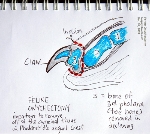|
toapayohvets.com Blk 1002, Toa Payoh Lor 8, 01-1477,
Singapore 319074. Tel: 6254-3326,
9668-6468.
judy@toapayohvets.com
|
|
|
|
1. How is declawing done? |
 2. Two reasons I would do declawing as a last resort and after asking the owners to wait and re-consider. These are damage to property and injury to family and other pets. These are the two reasons: The cat will be euthanased or sent to the animal shelter where they may be put to sleep or abandoned. 3. Besides anaesthetic risks, there may be post-operation complications like bleeding and infection. As in any surgery, asepsis, bleeding control, antibiotics and pain-killers prevent most complications. |
|
|


